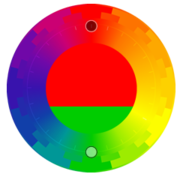Complementary color scheme
Complementary is a color scheme using one base color and its complement, the color on the exact opposite side of the color wheel. The base color is main and dominant, while the complementary color is used only as an accent. A combination of one warm and one cold color is always created. We have to consider, which one will be dominant, and which one one accenting. The choice decides whether the result palette will look warm, or cold. Various monochromatic shades of both colors could be added to the scheme.
The result is similar to the monochromatic color scheme, the palette is smooth and elegant, yet it's accompained by a quite expressive complementary color allowing to create vivid accents. If the complementary color is used more and stronger, or even if both the colors are comparable, used with similar strenth, the impression of the result will be stronger, bold, or even aggressive.
Examples
We can use the contrast scheme to create palettes with very similar, less contrast shades, as well as palettes of high contrast.
Paletton usage
Within the Paletton application there is the Monochromatic (1-color) option with complementary color switched ON, to create complementary schemes. The application creates only several shades of each color. You’ll be able to create others — more or less saturated, lighter or darker.




